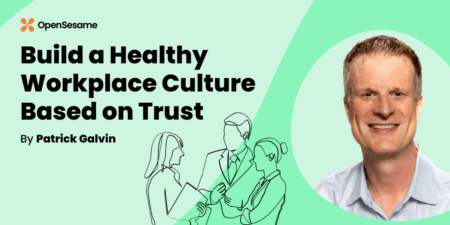Trust is an essential element of every healthy work relationship and the key to professional advancement. When work relationships are firmly rooted in trust, the result is improved communication and collaboration, greater creativity, increased happiness, and better career opportunities. Compared with people at low-trust companies, people at high-trust organizations report:
- 74% less stress
- 106% more energy
- 50% higher productivity
- 13% fewer sick days
- 76% more engagement
- 29% more satisfaction with their lives
- 40% less burnout
Conversely, a breakdown in trust can lead to conflict and keep employees from achieving their full potential. Without trust, the entire organization suffers. The amount of complaining rises and disengagement becomes a serious issue. Gallup estimates that employee disengagement costs the overall US economy as much as $350 billion every year, with each disengaged employee costing their employer up to $10,000 in lost productivity.
The takeaway? Trust is everything.
The Importance of Workplace Trust
As important as it is, trust is not something that we are born with or learn from our teachers at school. It does not come automatically with a job title or a position of authority. Sometimes, we don’t think about trust at all—until it is too late. As Warren Buffet noted, “Trust is like the air we breathe. When it is present, nobody really notices. But when it’s absent, everybody notices.”
So, what can an organization and its leaders do to nurture a culture of trust in which everyone thrives? It starts with a basic understanding of what trust in the workplace looks like.
When there is workplace trust, people feel valued, supported, and respected as individuals. In other words, they feel psychologically safe knowing that they can ask questions, make suggestions, offer feedback, take risks, and rely on their own judgment to make decisions and work uninterrupted without being monitored or micromanaged.
Of course, psychological safety doesn’t just happen—it requires careful thought and deliberate action, as well as an organizational-wide commitment to continuous learning. Below are three very specific ways to begin building an environment of trust where people feel more confident, creative, and productive.
- Operate with full transparency. If you wonder how much information to share with employees, remember this: The human brain works overtime when it doesn’t have accurate or timely information. This can lead to false assumptions and misunderstandings. Be clear about expectations, deadlines, and job roles. Give people the information they need so there is no room for misinterpretation. Importantly, don’t have private conversations about issues that involve everyone. Instead, use open communication channels to make sure everyone feels included and informed. Transparent communication builds trust and leads to a more collaborative workplace.
- Celebrate differences while looking for similarities. Inclusion is not about shying away from or ignoring differences. Rather, it is about acknowledging and accepting the fact that people bring diverse personalities, backgrounds, values, and traditions to the table. At the same time, people like and trust people who have similar interests and experiences. Look for opportunities to establish common ground around things such as shared values, goals, and hobbies as these are the foundations for close relationships. Similarly, focus on ways to create “win-win” situations. Working together for mutual benefit is a highly effective way to build trust.
- Use respectful and responsible language. Show respect for people’s differences and use positive, inclusive language that makes everyone feel part of the team. Ask employees about their language preferences and encourage all team members to learn more about managing unintentional bias and issues related to diversity and inclusion (by offering them training, for example). Psychological safety is one of the most important conditions for open and honest communication.
For more ways to build workplace trust, visit our full catalog of courses which is available through OpenSesame Plus and covers topics such as building trust with remote teams, navigating difficult work situations to preserve trust, communicating to build trust with employees, and creating a culture of trust in a diverse and inclusive workplace.
More about Peter Galvin
Patrick Galvin is a TEDx speaker, author, and the chief galvanizer of The Galvanizing Group, an OpenSesame Plus publisher whose courses emphasize the importance of earning trust and building strong and meaningful business connections.






